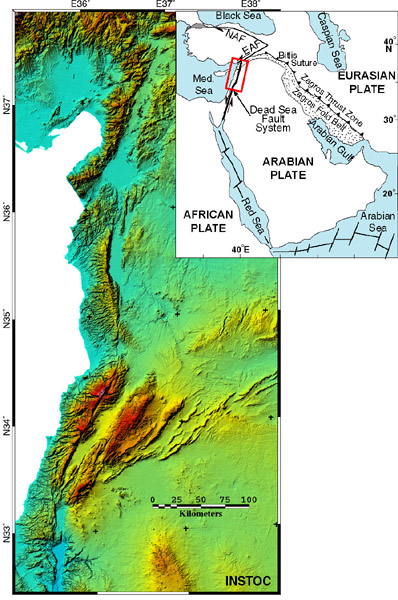
Active tectonics of the northern Dead Sea Fault System in Syria and Lebanon

 We
are conducting an interdisciplinary study of the active tectonics of the Dead
Sea Fault System (DSFS) in Syria and Lebanon. One motivation for this
research is the relative lack of information on this key plate boundary in the
eastern Mediterranean tectonic puzzle.
We
are conducting an interdisciplinary study of the active tectonics of the Dead
Sea Fault System (DSFS) in Syria and Lebanon. One motivation for this
research is the relative lack of information on this key plate boundary in the
eastern Mediterranean tectonic puzzle.
In collaboration with researchers in the region, as well as colleagues
in the U.S. and France, this project has several facets:
-
Neotectonic/paleoseismic field-based studies to assess the late Quaternary
rates of deformation and the geological record of late Pleistocene and
Holocene earthquakes.
-
GPS geodesy to measure short-term crustal deformations
-
Remote sensing applications (InSAR, Landsat, etc.) to identify the possible
regional extent of the neotectonic deformations.
These studies are strengthened by considerable work on the historical and archeological
record of earthquakes in Syria and Lebanon previously conducted by colleagues
in Syria, as well as ongoing seismological studies by Syrian colleagues.
Right: Shaded relief image of the northern Dead Sea Fault System.
Publications
More information:
Participants:
Collaborating Institutions:
- Higher Institute for Applied Sciences and Technology (Syria)
- Damascus University (Syria)
- Syrian Atomic Energy Commission
- Tishreen University (Syria)
- Syrian National Earthquake Center
- Lebanese National Center for Remote Sensing
- Lebanese American University
- American University of Beirut (Lebanon)
- IPG Strasbourg, France
- Earth Resources Laboratory at MIT
Acknowledgments
This material is partially based upon work supported by the National Science
Foundation. Any opinions, findings, and conclusions or recommendations expressed
in this material are those of the author(s) and do not necessarily reflect the
views of the National Science Foundation. SAR data have been provided
by a data grant from the European Space Agency (ESA).
Return
to Current Projects
For
questions or comments, please contact Muawia Barazangi: mb44@cornell.edu.
Last
updated: May 2010
 We
are conducting an interdisciplinary study of the active tectonics of the Dead
Sea Fault System (DSFS) in Syria and Lebanon. One motivation for this
research is the relative lack of information on this key plate boundary in the
eastern Mediterranean tectonic puzzle.
We
are conducting an interdisciplinary study of the active tectonics of the Dead
Sea Fault System (DSFS) in Syria and Lebanon. One motivation for this
research is the relative lack of information on this key plate boundary in the
eastern Mediterranean tectonic puzzle.